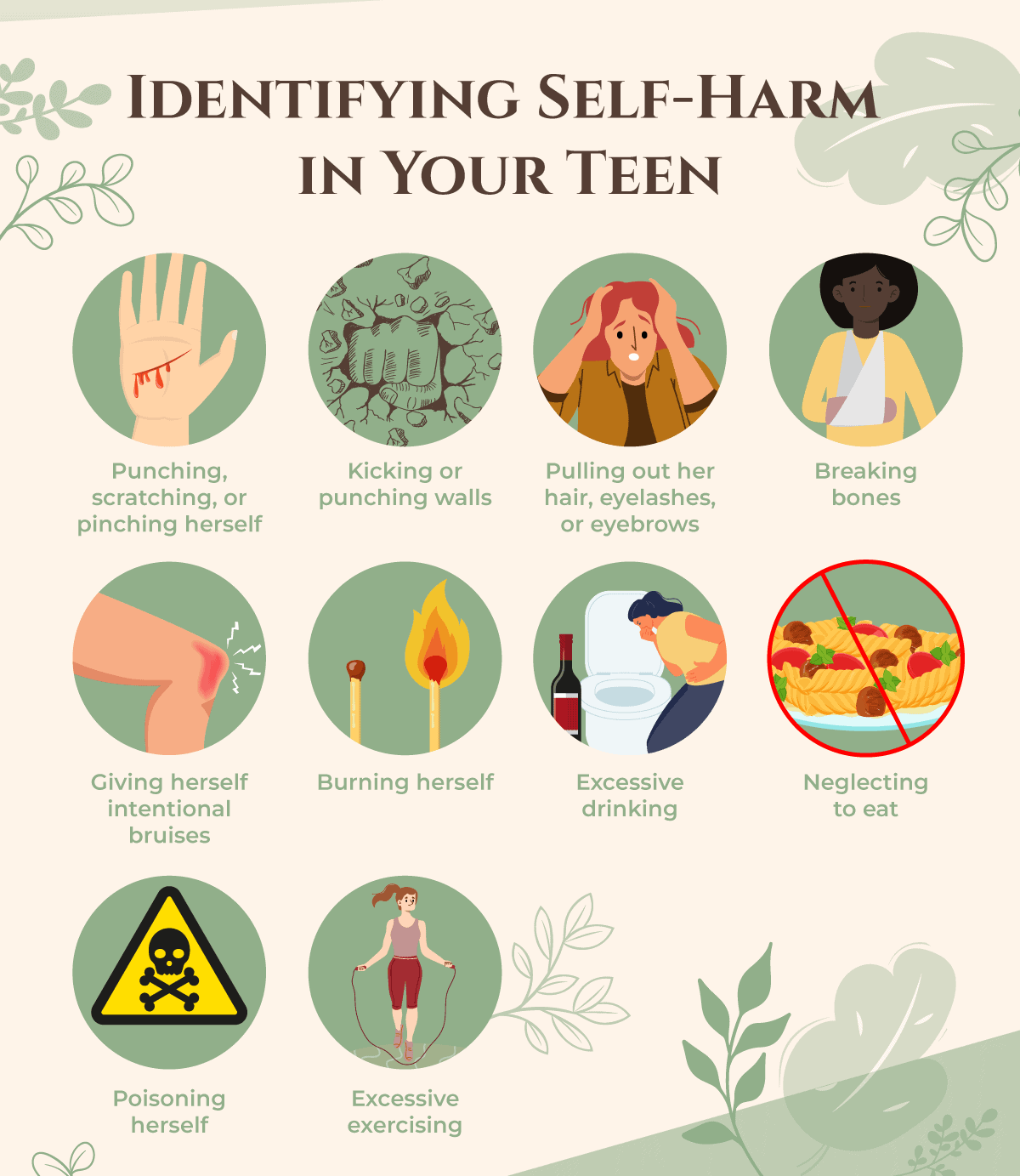
We spend so much time trying to protect our daughters – the idea of them hurting themselves is almost unfathomable. When we notice self-harming behaviors, it can be scary or overwhelming. Unfortunately, it does happen. Especially if your child is living with untreated depression, anxiety, or other mood disorders. The rates of major depressive episodes among adolescents, including instances of self-harm, have increased by 52% between 2005 and 2017 (from .1% to 13.2%) in Texas. But why does this happen? How can we stop it?
At Roots Renewal Ranch, we know self-harm is usually a sign that something deeper is going on. If you suspect that your daughter is hurting herself intentionally, you’re right to be concerned. Fortunately, there is evidence-based treatment available to get her through this. Let’s talk about self-harm, what causes it, and what it looks like.

What is Self-Harm, Anyway?
Self-harm usually happens when a person doesn’t have healthy coping mechanisms in place. It’s when a person will physically hurt themselves to handle complicated, difficult feelings or situations. It’s what happens when someone doesn’t know what to do with a build-up of significant emotional discomfort.
Self-harm happens more in teens than adults because their hormones are high and their experience is low – they don’t understand what many of these hard feelings are or what they mean.
It’s rare for a mentally-healthy teen to participate in self-harm. Once healthy coping strategies are identified and intense feelings are understood, the urge to hurt oneself dissipates. When depression, anxiety, or other mental disorders go untreated, a teen’s behavior doesn’t end in self-harm. It can often progress to reckless or self-sabotaging behavior, suicidal ideations, or suicide attempts. This is why, when your teen is exhibiting this behavior, mental health treatment is almost always recommended.
Why Would My Daughter Want to Harm Herself?
Here are some common reasons why your daughter might participate in self-harm:
- She is using it as a coping mechanism
- She’s trying to express something that she can’t find the words to describe
- She’s trying to turn emotional pain into physical pain
- She’s trying to distract herself from overwhelming feelings, situations, or unresolved trauma
- She uses it as a way to take control of her situation or emotions
- She feels numb, and the only way she can feel something is by inflicting pain on herself
- She’s thinking about suicide or she feels suicidal, but she doesn’t want to give in to those thoughts
A good way to look at self-harm is to imagine a volcano. Eventually, the pressure and the heat are so intense that the volcano has to explode. Teen emotions are just like that. They build over time and they’re not often resolved. Eventually, those feelings need a place to go. Your daughter might find a release in hurting herself. It may be hard for you to imagine physical pain as a relief, but this is how many teens feel. The emotional pain can get so intense that physical pain feels minor in comparison.

Identifying Self-Harm in Your Teen
When we see acts of self-harm in movies or TV shows, it’s usually cutting. A teen might cut her wrists and cover her wounds with long-sleeved shirts or sweaters. In the movies, she does it quietly in the bathroom and works to disguise the evidence from her parents. Sometimes, this is how teens harm themselves. However, it’s not the only form they’ll participate in. Some other forms of self-harm include:
- Punching, scratching, or pinching herself
- Kicking or punching walls
- Pulling out her hair, eyelashes, or eyebrows
- Breaking bones
- Giving herself intentional bruises
- Burning herself with matches, candles, cigarettes, lighters, or the stove
- Excessive drinking to the point of vomiting or frequent hangovers
- Neglecting to eat (starving herself, anorexia, bulimia)
- Poisoning herself with household products or medication
- Excessive exercising
Many acts of self-harm are difficult to recognize. You won’t always know if your daughter is hurting herself because she’ll likely do it in private. She may hide things like drinking and drug use or excessive exercise. A lack of evidence on her body, like scratches or cuts, does not mean she’s not hurting herself. That’s where it gets difficult. How can you look out for signs of self-harm if your daughter is hiding them from you?

Aside from obvious cuts, bruises, or other physical injuries, there are things you can look out for that may be indicators of self-harm in your daughter:
- Negative self-talk. If your daughter is incredibly hard on herself or if she talks down to herself, this can be a sign that she’s experiencing self-loathing. This might sound like “everyone hates me”, “I’m so ugly”, or “why would anyone want to talk to me?”
- Bald patches. A common behavior indicating self-harm is pulling hair out, so keep your eyes on her scalp and eyes.
- Alcohol or drug use. Any alcohol or drug use is unhealthy for a teen. Their brains aren’t fully developed yet, and their decision-making skills haven’t matured. If you notice drug or alcohol use, it’s time to address it and possibly seek treatment if necessary.
- She talks about how she’s too tired to go on, how she wants it all to end, or how she feels hopeless. These are serious statements, and they’re often used by teens who are physically or emotionally hurting themselves. Keep an ear out.
- She’s isolating herself from others. Isolation can simply mean your teen has a lot of schoolwork, is introverted, or just prefers the company of her family in her own home. But if she was social and enjoyed being around others, becoming withdrawn or isolating herself can be a sign that she’s harming herself and doesn’t want anyone to know about it.
- She’s being secretive about eating. If your daughter suddenly only wants to eat in her room or out of the house, it could mean she’s avoiding food.
- Her mood is always low, she doesn’t spend time on her hobbies anymore, she has frequent crying spells, or she’s sleeping too much. These are usually indicators that something is wrong, and they usually point to depression, anxiety, or a mood disorder. Again, some teens display these behaviors naturally due to personality or changing hormones. If this change is sudden or if she doesn’t seem like herself, that could indicate that there’s more going on.

Things You Can Do to Help Your Daughter
100% of the time, self-harm is a sign of mental distress. If you suspect that your teen is hurting herself, start with an open conversation. Express concern, avoid judgment and practice active listening. Stay calm. If an argument ensues it could cause your daughter to not want to confide in you. If an argument begins, end the conversation and come back to it when you are better prepared.
Provide a safe environment for her to talk, and don’t shy away from the topic of self-harm. You can openly discuss the dangers of self-harm and remind her that you’re always available if she wants to talk. The last thing she needs is comments about how she should “just stop”, how wrong self-harm is, or that there’s something wrong with her. She’s likely already experiencing feelings of guilt and shame.

The best thing you can do for your daughter is to consider mental health treatment. There are evidence-based, effective therapies for teens who are participating in self-harm. The root cause of this behavior needs to be addressed so she can fully heal. Many teens fully recover from self-harm or mental distress.
At Roots Renewal Ranch, we use a comprehensive whole-child approach to implement a safe, nurturing, and distraction-free environment for emotional growth and healing. We want your daughter to journey through her story and discover a loving sense of self. Here, we build hope in a healthy and purposeful life while helping your daughter develop the whole-hearted belief that she is worthy of love and happiness. If you think your daughter could benefit from self-harm treatment, call us today at 888-399-0489 so we can help.

FAQs About The Different Types of Self Harm In Teens Girls
What can I do if someone I love is harming themselves?
Stay calm and create a safe environment where your loved one feels comfortable talking. Practice active listening, and try not to interrupt or judge. Always encourage mental health treatment.
Is self-harm a mental health issue?
Self-harm always indicates mental distress. That doesn’t mean the person participating in self-harm definitely has a mental health disorder, though that can be the case. Mental distress in teens can also be brought on by stress, hormones, bullying, peer pressure, and more.
Is there a correlation between social media and self-harm?
If your child is being bullied online, it could cause enough mental distress for them to participate in self-harm.
Click to copy and share:

